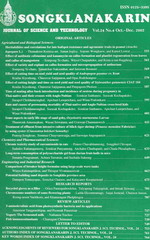ThaiScience
ThaiScience
SONGKLANAKARIN JOURNAL OF SCIENCE & TECHNOLOGY
Volume 41, No. 01, Month JANUARY, Year 2019, Pages 45 - 52
First detection of white spot syndrome virus (wssv) in wild mud crab scylla spp. (de haan, 1883) from setiu wetlands, malaysia
Nurshafiqah Norizan, Faizah Shaharom-Harrison, Marina Hassan, Najiah Musa, Nadirah Musa, Muhd Effendy Abd Wahid, and Sandra Catherine Zainathan
Abstract Download PDF
In this study, tissue samples from 90 wild mud crabs (Scylla spp. including S. olivacea, S. Tranquebarica, and S. paramamosain) were collected during pre-monsoon, monsoon, and post-monsoon in the Setiu Wetlands, Terengganu, Malaysia. The tissue samples were screened for the presence of white spot syndrome virus (WSSV) by PCR. This study was conducted to detect the presence or absence of WSSV in wild Scylla spp. from the Setiu Wetlands at different times of sampling. WSSV DNA was detected in 36% of the mud crabs. The DNA sequence of a 941 bp genome region amplified from a crab by PCR was identified to be most similar (99% nucleotide sequence, 98% amino acid sequence) to a WSSV strain detected in Mexico (KU216744.1) and Taiwan WSSV 419 strain (AY850066.1). The data indicated that mud crabs in the Setiu Wetlands might act as a WSSV reservoir of risk to shrimp aquaculture. Our findings are the first detection of WSSV from wild mud crabs, Scylla spp. in the Setiu Wetlands, Terengganu, Malaysia.
Keywords
mud crab, Scylla spp., white spot syndrome virus, PCR, Setiu WetlandsSONGKLANAKARIN JOURNAL OF SCIENCE & TECHNOLOGY
Published by : Prince of Songkla University
Contributions welcome at : http://rdo.psu.ac.th
